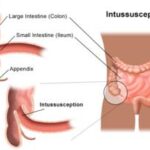While it’s potentially life-threatening, intussusception of the intestines in dogs is fortunately rare. Although this condition can strike dogs of all ages, puppies are more at risk than older dogs. According to peteducation.com, no specific breed appears to have a tendency toward developing the problem.
During an intussusception, a portion of the dog’s intestine telescopes or slides within itself. This can occur in either the small or the large intestine, but it’s more common in the small bowel.
Once a segment of intestine has moved within another piece, its blood supply is shut off or at least greatly reduced. The tissue will first swell, then die. Because the process happens so fast, it’s essential that the dog get diagnosed and treated right away if it’s to survive.
Several conditions can predispose a dog to developing this problem. Many of them are related to the intestine’s degree of motility. Experts report that puppies experience more intussusceptions than older dogs due because of the presence of a lot of intestinal parasites like roundworms, hookworms or whipworms. Other possible causes are contracting parvovirus as a puppy or experiencing bacterial gastroenteritis.
Since many dogs love to chew, ingesting pieces of plastic, bone or wood can also cause the problem. Sometimes it occurs when the dog experiences tumors or has had recent abdominal surgery.
Once the intestine telescopes, food or fecal matter becomes partially or totally blocked. The dog usually starts to vomit. After the part of the intestine behind the intussusception has cleared, the pet will pass few if any stools. Any remaining fecal matter will resemble jelly and will not be well formed. It might also look bloody. The pet’s appetite will dramatically decrease.
The dog will be in obvious pain. This can eventually lead to shock. If the condition isn’t treated promptly, the dog will die.
A veterinarian diagnoses an intussusception after palpating the dog’s abdomen, taking a history and observing symptoms. Any firm sausage-shaped mass can be an indicator of the problem. Upon finding the mass, the vet will order X-rays, sometimes using barium, to make a final diagnosis. If the results are inconclusive, the dog might require exploratory surgery.
Once an intussusception has been confirmed, the treatment is one of two types of surgery. As the intestine telescopes, the resulting pressure restricts blood flow to that segment of bowel. It might actually die and release toxins and bacteria into the remainder of the body.
One surgical technique is to slide the telescoping segment of the intestine into the correct position. The second involves completely removing the intussusception and any surrounding damaged tissue. The type of surgery required is dictated by how long the animal has had the problem, the extent of tissue damage and the size of the intussusception.
When an owner recognizes the early signs of an intussusception and gets the dog quickly to a vet for treatment, there’s a good chance that surgery will be successful.
Reference:
- peteducation.com web site






